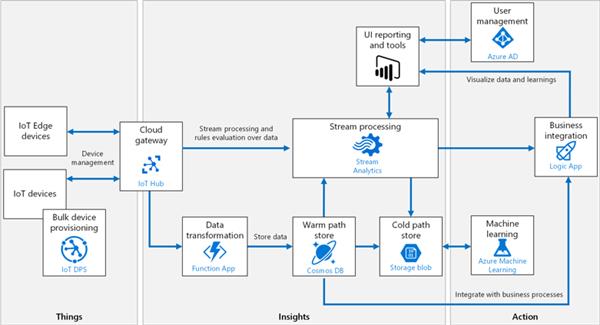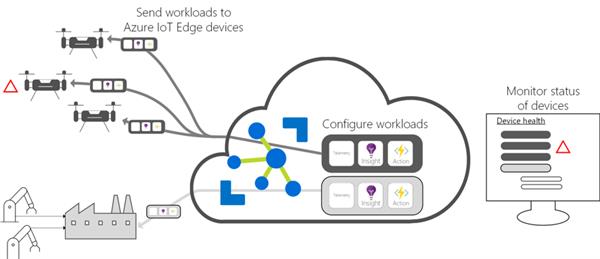What is Azure IoT Edge - Azure IoT Part 4
- Pre-requisite Knowledge –
Before you understand the Azure IoT (Internet of things) Edge, I recommend you should know –
- Basic knowledge of cloud computing
- Basic knowledge of Microsoft Azure and pillars of Azure cloud
- Basic knowledge of IoT, Microsoft Azure IoT
- Basic knowledge of IoT Architecture
- Basic knowledge of IoT Hub
- Background –
In my previous articles, we have seen an overview of Internet of Things (IoT), Azure IoT architecture and IoT Hub. In this article, I would like to explain what Azure IoT Edge is.
- Azure IoT Edge-
As we have seen, Azure IoT applications are based on TIA –
- Things - which are nothing devices which send data
- Insights - to generate meaningful data which is useful for a business need
- Actions – Activities to improve the business based on the data output generated from insights

Now we know, Azure IoT hub can handle millions of digital devices and those can securely communicate with Azure services for further processing of data. It can be vice-a-versa as well, Azure IoT can work a hub to transfer the messages from Azure backend services to the devices. Azure IoT enables highly secure and reliable communication between your IoT application and the devices it manages.
Edge computing is the latest methodology for the next of the traditional cloud computing model. Why it is so – Because edge computing allows to perform the business logic (compute), storage and networking in local which gives us additional benefits of offline availability, reducing bandwidth consumption with public cloud and run the machine learning program locally.
With reference to the above picture of IoT architecture, we have three coatings – IoT devices, IoT Edge and public cloud. Now, consider we have machine learning models are in public cloud meaning public cloud backend services will learn the data captured from devices to mature the machine learning based on the historical data. In this scenario, edge devices will make decisions based on the machine learning model. According to the decision of edge, IoT devices will perform the action. Analytics is the core era in IoT. If we want the device to respond quickly then we can execute anomaly detection workloads at the edge. It is not always required to execute the analytics logic decision on the public cloud. We can clean, shaping od data before sending to the Azure public cloud in the edge. It also helps us to reduce the to reduce bandwidth costs and avoid transferring terabytes of raw data.
IoT edge is built on IoT Hub. It is a new addition to the IoT. Azure IoT Edge seamlessly manages the interaction between devices and public cloud. IoT Edge can be deployed on to Microsoft Windows as well as on Linux ARM & x64 operating systems. We can leverage the existing skills to implement IoT edge since it has support to different languages such as C, C#, Java, Node.js, and Python.
IoT edge has major three components –
- IoT Edge Modules –
The devices are connected to the IoT edge instead of directly connected with the cloud services. Devices have modules registered with the IoT edge layer. These modules are managed by the IoT runtime agent. It means IoT edge modules are the docker containers, azure services, code logic, third party services. IoT edge is the representatives of the devices. It is not always required modules to relate to the devices meaning there are loosely coupled. IoT Edge modules can communicate with each other. Azure IoT Edge allows us to deploy complex event processing, machine learning, image recognition, and other high-value AI.
- IoT Edge Runtime –
The Azure IoT Edge runtime enables custom and cloud logic on IoT Edge devices. It controls and manages the secured interaction of Azure IoT control panel in the cloud. This component needs to install on each device which is registered with the cloud. It manages several functions like security standards, workloads on the device, ensures modules are always running, etc. The Azure IoT Edge runtime runs on a large set of IoT devices to enable using the runtime in a wide variety of ways and its supports to Windows as well as Linux operating systems.
- Cloud-based Interface –
Millions of communication and events happen in the IoT solutions with millions of IoT devices with there modules and different geographical locations. It is quite challenging to monitor individual device and its behavior. IoT edge cloud interface gives us a single control plane to control this. It helps in various ways like create and configure a workload for a specific type of device or a set of devices and monitor workloads. In short, it helps us to remotely manage and deploy workloads.

Image Source – Microsoft Docs
Azure IoT Edge Pricing – Refer this page
Conclusion - In this article, we have learned overview of Azure IoT Edge. In the next article, we will see more about Azure IoT Central. Stay tuned!





